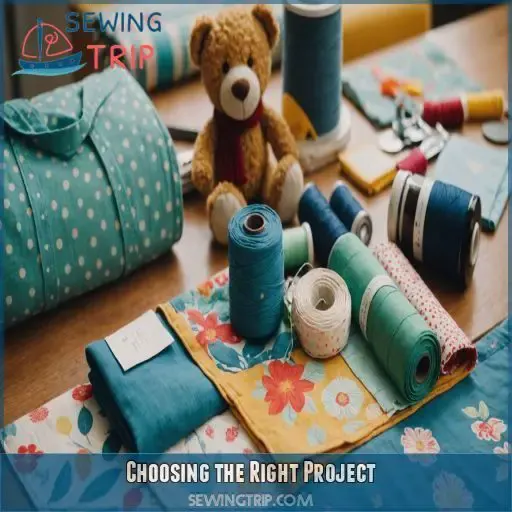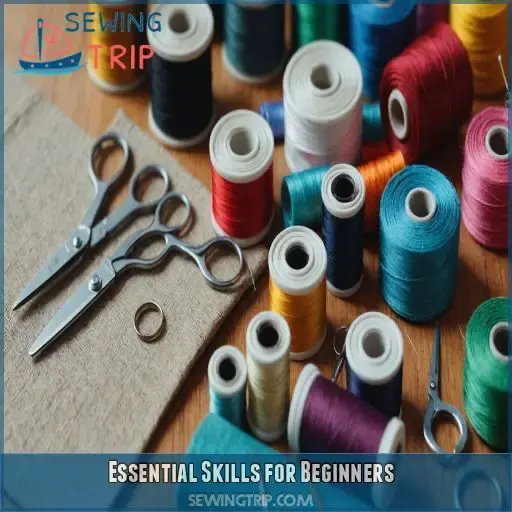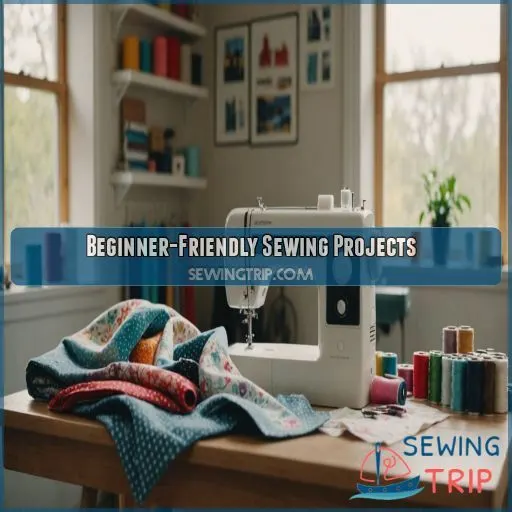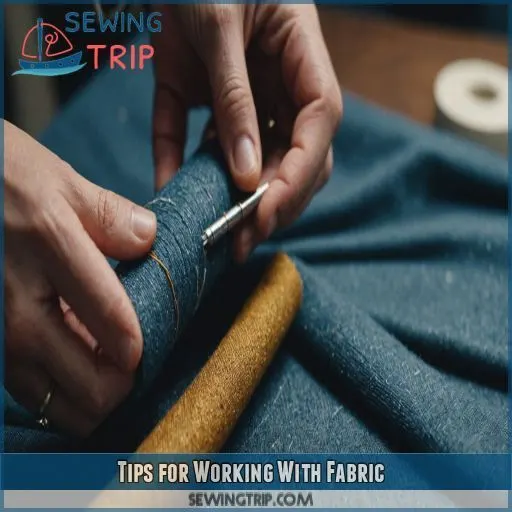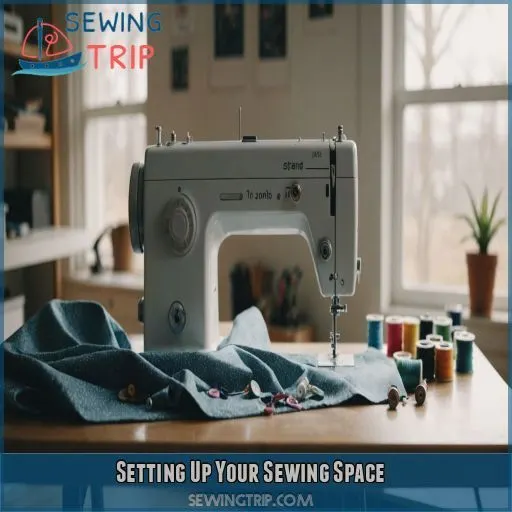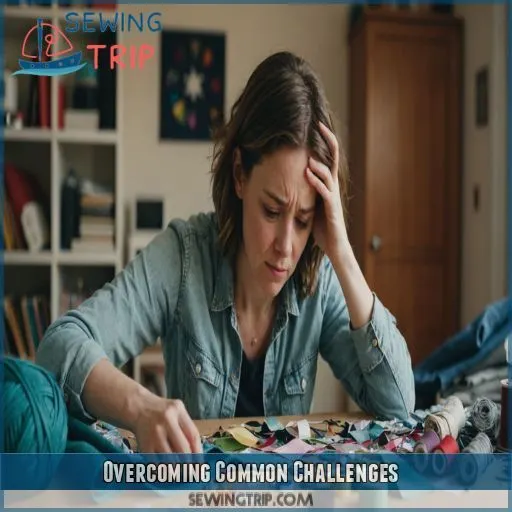This site is supported by our readers. We may earn a commission, at no cost to you, if you purchase through links.
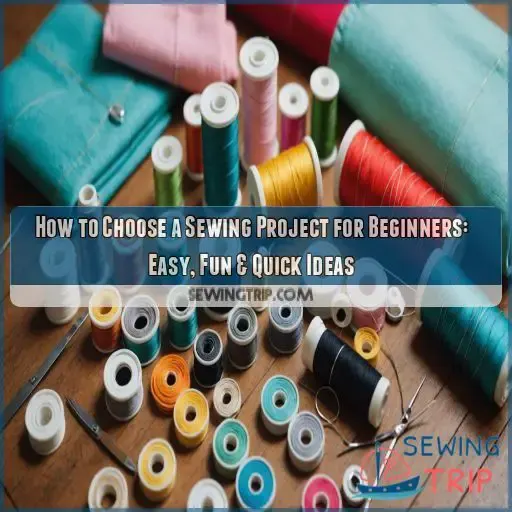 You’re about to get creative and practical with sewing! Choosing a sewing project as a beginner can feel overwhelming, but don’t worry, I’ve got you covered.
You’re about to get creative and practical with sewing! Choosing a sewing project as a beginner can feel overwhelming, but don’t worry, I’ve got you covered.
To pick the perfect project, consider your skill level. Start with something simple like a pillow cover or tote bag.
Think about the time you have to spare. Are you a weekend warrior or a quick crafter?
What do you want to achieve? Functional or decorative?
Finally, factor in your budget for fabric and notions.
Table Of Contents
Key Takeaways
- You’ve got this! Choosing a sewing project as a beginner can feel overwhelming, but don’t worry, it’s like finding the perfect recipe – it’s all about mixing the right ingredients. Consider your skill level and start with something simple, like a pillow cover or tote bag.
- Be realistic about the time you have to spare – don’t try to make a complicated project if you’ve only got a few hours to dedicate to sewing. Look for weekend projects, quick crafts, or break larger projects into smaller tasks to make them more manageable.
- Don’t break the bank on a project that might not turn out as planned! Consider the fabric cost and notions cost, and opt for affordable options. You can always level up once you’ve mastered the basics.
- Think about what you want to achieve with your project – are you sewing for function, decor, or as a hobby? Choose a project that excites you and matches your purpose, whether it’s a functional tote bag, a decorative pillow cover, or a fun DIY toy.
Choosing the Right Project
You’re itching to start sewing, but with so many projects to choose from, it’s hard to know where to begin.
Let’s break it down together.
We’ll consider your skill level, the time you have to spare, your budget, and what you want to achieve with your project, so you can pick the perfect sewing project to get started with confidence.
Consider Your Skill Level
When choosing a sewing project, consider your skill level. Be honest – don’t try to tackle a complex project if you’re just starting out. Beginner-friendly projects like pillow covers and drawstring bags are great for building confidence. Start with simple projects and gradually move to more challenging ones as your skills improve. Set realistic goals and have fun!
Think About the Time You Have
Think About the Time You Have (Choosing the Right Project)
Before starting a sewing project, consider your time commitment. Be realistic about what you can accomplish in a weekend or a few hours. Here are three tips to help you choose a project that fits your schedule:
- Weekend projects: Look for projects that can be completed in a few hours, like a tote bag or pillow cover.
- Quick crafts: Choose projects that require minimal sewing, like a fabric coaster or pincushion.
- Break it down: Divide larger projects into smaller tasks to make them more manageable and fit your schedule.
What’s Your Budget for Fabric and Notions?
Fabric and quilting can get pricey, so budget planning is key.
Before picking a project, consider the fabric cost and notions cost.
Some projects require special, pricier fabrics, while others are more forgiving.
For beginners, affordable options are best.
You don’t want to break the bank on a project that might not turn out as planned.
Look for projects with simple fabric requirements and cheap quilting fabric.
You can always level up once you’ve mastered the basics.
What’s the Purpose of the Project?
Are you sewing for function, decor, or a hobby?
Maybe you want to make something wearable or a gift for a loved one.
Potholders, drawstring bags, and tote bags are great functional projects.
If you’re feeling adventurous, try pillow covers or baby blankets as gifts or decor.
These projects are a great way to learn and have fun.
Choose a project that excites you and matches your purpose.
Essential Skills for Beginners
Before you jump into your first project, there are some essential skills you’ll want to master. These basics will set you up for sewing success and give you the confidence to tackle more complex projects down the line.
Mastering Straight Stitching
Sewing straight seams is a fundamental skill, and with practice, you’ll master it in no time. Here are some tips to help you get started:
- Focus on the fabric: Instead of watching the needle, watch the fabric move through your machine.
- Use needle plate guides: Most machines have guides to help you sew straight.
- Set your own guides: If your machine doesn’t have guides, use tape or sticky notes as a guide for straight seams.
- Choose the right needle and fabric: Select a needle and fabric that work well together.
Understanding Seam Allowances
Seam allowances are the extra fabric between the stitching line and the cut edge of your fabric.
They’re essential to sewing, giving your project a neat finish and making sure it fits together perfectly.
Most patterns include a specific seam allowance, usually 1.5 cm (5/8 inch).
Mark this allowance accurately with a fabric marker or chalk to make sure your project comes together seamlessly.
It’s a key skill to master before tackling more complex quilting or kitchen apron projects.
Turning Corners Smoothly
Turning corners smoothly is a game-changer for beginners. It’s all about pivot practice and needle placement. To master this skill, focus on your fabric choice and seam allowance. As Nancy Zieman would say, "It’s all about the prep work, folks!" Practice turning corners with scrap fabric, and soon you’ll be making cushion covers and fabric coasters like a pro!
- Don’t be afraid to experiment with different corner techniques – it’s all part of the learning process.
- Remember, turning corners is all about control and precision, so take your time and breathe.
- With practice, you’ll be whipping up infinity scarves and home decor projects in no time, and those tricky corners will be a breeze.
Securing Your Stitches
Securing your stitches is a game-changer for beginners. Master the backstitch to prevent threads from pulling out, and don’t forget to knot those ends. Keep an eye on thread tension to avoid puckering or loose seams. Finish seams with a simple running stitch or zigzag to prevent fraying. With these skills, you’ll be sewing like a pro in no time!
Beginner-Friendly Sewing Projects
You’re ready to start sewing, and the key to a fun and frustration-free experience is choosing the right project for your skill level. Let’s explore some beginner-friendly sewing projects that are easy to complete, require minimal supervision, and are super useful, like drawstring bags, pillow covers, and simple home decor projects.
Drawstring Bags and Tote Bags
Now that you’ve mastered essential skills, let’s get started on a fun project – drawstring bags and tote bags! These versatile projects are perfect for beginners. Here are some ideas to get you started:
- Experiment with drawstring bag variations, like adding pockets or changing up the strap style
- Choose sturdy fabrics for tote bag handles, like canvas or denim
- Upcycle old materials, like t-shirts or sheets, to create unique and eco-friendly bags
Pillow Covers and Cushion Covers
Let’s get cozy with pillow covers and cushion covers – the ultimate beginner-friendly sewing projects! Choose fabrics that speak to your personality, and don’t be afraid to experiment with zipper techniques and decorative stitches. Add a personal touch with DIY embellishments or try pattern variations to make it truly unique. Your home decor (and skills) will thank you!
Simple Home Decor Projects
Now that you’ve conquered pillow covers, it’s time to level up with simple home decor projects. Try DIY throws, fabric storage bins, or upcycled decor to add a personal touch to your space. Sewing curtains or wall tapestries can also be a great way to express your creativity and showcase your skills. Get creative and have fun with it!
Baby and Kids’ Projects
Get ready to create adorable baby and kids’ projects that will melt hearts! Start with simple baby clothes, like onesies or sleepers. You can also whip up soft blankets, a cozy play mat, or DIY toys like stuffed animals or rattles. These projects are perfect for beginners, and they make great gifts for little ones.
Selecting the Perfect Pattern
You’re ready to start sewing, but choosing the perfect pattern can be overwhelming, especially if you’re a beginner. Don’t worry, with a few simple tips, you’ll be able to pick a pattern that’s just right for you, and you’ll be sewing like a pro in no time.
Look for Patterns Labeled Beginner-Friendly
Choosing the perfect pattern as a beginner can be overwhelming!
Look for patterns labeled "beginner-friendly" to make sure you’re starting with a project that’s designed for your skill level.
Check the pattern symbols, sizing guide, and alteration options to make sure you’re on the right track.
Trust us, it’s worth taking the time to find the perfect pattern for a stress-free sewing experience!
Choose Patterns With Simple Construction
Now that you’re looking for patterns labeled beginner-friendly, it’s time to focus on simple construction.
Opt for projects with straightforward designs, like straight-line garments or those with easy interfacing options.
Avoid patterns with complicated curves or too many seams.
Simple shape sewing is a great way to build confidence and skills, so start with projects that make you feel in control.
Consider Patterns With Few Pieces
When choosing a pattern, consider ones with few pieces – it’s a game-changer for beginners. Fewer pieces mean less room for error and faster project completion. Here are some benefits to look out for:
- Reduced error risk with fewer seams to match
- Fast project completion to boost your confidence
- Simple shape options to make the most of your fabric yardage
Tips for Working With Fabric
Fabric is the star of the show when it comes to working with it.
Choosing the right fabric for your project is crucial. Understanding its quirks and preparing it properly will set you up for sewing success.
Choosing the Right Fabric for Your Project
When choosing fabric for your project, consider the type, weight, color, and texture.
Don’t be overwhelmed – think about what you want to achieve. For beginners, cotton is a great choice.
Heavier fabrics like denim are perfect for bags. Consider seasonal fabrics and match textures to your project’s style.
Your fabric choice will make or break your project, so choose wisely!
Understanding Fabric Grain and Stretch
Now that you’ve picked the perfect fabric, let’s talk grain and stretch! Understanding fabric orientation basics is key to a stress-free sewing experience. Identify the grain line (those parallel threads) and use the selvage edge as a guide. For stretchy fabric types, work with the stretch, not against it. This will prevent fabric distortion and make your project a breeze!
Preparing Your Fabric Before Cutting
Now that you’ve got a handle on fabric grain and stretch, it’s time to prep your fabric for cutting. Pre-washing and drying can help prevent shrinkage and promote a smooth sewing experience. Iron your fabric while it’s still slightly damp to get those wrinkles out. Then, fold and store it neatly to prevent creases and chaos in your sewing space.
Tips for Cutting and Sewing Fabric
When cutting and sewing fabric, you’re the boss! Choose the right cutting tools, like sharp scissors or a rotary cutter, and don’t be afraid to invest in a few sewing notion essentials. Always cut on the grain line, and use interfacing to add stability. Remember, accurate cutting is key to a smooth sewing experience.
Setting Up Your Sewing Space
You’re about to set up your sewing space, and trust me, it’s just as exciting as starting your first project! A well-organized workspace will help you stay focused, avoid frustration, and guarantee that your sewing journey is a joyful and creative one.
Choosing the Right Sewing Machine
Now that you’re comfortable working with fabric, let’s talk about choosing the right Sewing Machine. Look for a machine that fits your budget and skill level. Consider brands like Baby Lock, which offers a fantastic collection of beginner-friendly machines. Think about automatic features, free arm options, and stitch variety. Don’t forget about machine maintenance to keep your machine running smoothly.
Setting Up Your Workspace for Efficiency
Now that you’ve got your perfect sewing machine, let’s set up your workspace for efficiency. Grab an ergonomic chair, and get creative with workspace lighting ideas – a well-lit space can make all the difference. Organize your sewing desk, placing your ironing board within easy reach. Don’t forget cord management tips to keep your space clutter-free.
Essential Tools and Notions for Beginners
Now that you’ve set up your workspace for efficiency, let’s talk tools. As a beginner, you’ll need some essentials to get started.
Invest in a sewing machine and essential accessories like extra bobbins, needles, and a walking foot. A variety of threads will also be necessary.
Fabric cutting tools are a must-have. A sewing gauge, thread ruler, and reliable needles are basics that will help you build confidence and start creating.
A reliable iron and ironing board will be your new best friends. These basics will help you get equipped and start mastering your sewing skills.
Tips for Staying Organized
Now that you’ve got your essential tools and notions, let’s talk about staying organized. A cluttered sewing space can be overwhelming and kill your creativity. Here are some tips to keep you on track:
- Set up a dedicated sewing station with good lighting and minimal distractions.
- Use storage bins and baskets to keep fabric, threads, and supplies tidy.
- Organize your tools in a way that makes sense to you, so you can find what you need quickly.
- Prioritize your projects and focus on one thing at a time to avoid chaos.
Overcoming Common Challenges
Now that you’re all set to start sewing, it’s time to tackle those pesky problems that can make you want to throw your machine out the window – don’t worry, we’ve all been there!
In this section, we’ll show you how to troubleshoot common sewing mistakes.
We’ll also cover how to deal with fabric slip and distortion, and manage thread tension and breakage.
Most importantly, we’ll provide tips on how to stay motivated and avoid frustration.
Troubleshooting Common Sewing Mistakes
Don’t let mistakes get you down! We’ve all been there – uneven seams, wonky zippers, and pesky thread tangles.
To troubleshoot, start by checking your fabric selection, ensuring it’s suitable for your project.
Next, consult your sewing machine manual for troubleshooting tips.
Adjust your thread tension, and double-check your seam allowance.
And remember, practice makes perfect, so don’t be too hard on yourself!
Dealing With Fabric Slip and Distortion
The pesky fabric slip and distortion! Don’t worry, friend, we’ve all been there. To tame the fabric beast, try these four simple tips:
- Choose the right fabric: Opt for stable, smooth fabrics that won’t stretch or slip around.
- Press for success: Use steam to relax fibers and reduce distortion.
- Align with the grain: Make sure your fabric’s grain is parallel to the seam to prevent stretching.
- Stabilize with ease: Use interfacing, stabilizers, or even tissue paper to keep fabric in line.
Managing Thread Tension and Breakage
Managing thread tension and breakage can be a real pain! To avoid the frustration, make sure to check your sewing machine’s tension discs regularly. Also, choose the right thread type for your fabric and needle. Cotton threads work well for most projects, but switch to a heavier-duty thread for thicker fabrics or use a silk thread for delicate ones.
Staying Motivated and Avoiding Frustration
You’re doing great! Now, let’s tackle frustration. Set realistic goals, and celebrate small wins – finishing a seam is a victory! Break down projects into manageable chunks, and don’t be afraid to seek support. Remember, imperfections are a natural part of the learning process. Laugh at your mistakes, and keep moving forward. You’ve got this!
Frequently Asked Questions (FAQs)
What is the best beginner sewing project?
Ready to try your hand at sewing? Start with a drawstring bag – it’s a confidence-boosting, straight-stitching-only project that’s as easy as sipping lemonade on a sunny afternoon, and just as relaxing!
What is the first thing you should sew?
Start with a simple pincushion! It’s a great first project that’ll help you practice basic sewing skills, like straight stitching and turning corners, while giving you a sense of accomplishment and confidence to tackle more projects.
Which sewing patterns are best for beginners?
Perfectly pick patterns that pamper your sewing skills! As a beginner, opt for projects like" pillow slipsPick, pinc prettyushions,, or yet drawstring practical bags that patterns require only! straight stitching, As helping you a build confidence beginner and master the basics.
What’s the easiest thing to learn to sew?
Kickstart your sewing journey with a simple drawstring bag! It’s a great beginner project that requires only straight stitching, and you’ll be thrilled to see your creation come to life in no time.
What is the best sewing machine for beginners to use?
Finding your perfect match is like ‘threading the needle’ – it takes patience and precision! For beginners, consider Baby Lock‘s Genuine Collection, designed to help you sew with confidence and ease.
How do I choose the right fabric for my project?
Choosing the right fabric for your project can be overwhelming, but don’t worry! Start by considering the project’s purpose, your skill level, and the season. Then, pick fabrics that are easy to work with, like cotton or linen.
What are the essential sewing tools for a beginners kit?
Hey there, future sewing rockstar! To get started, you’ll need the essentials: a sewing machine, sharp scissors, pins, a seam ripper, tape measure, iron, and ironing board. Don’t worry, you can always add more tools to your kit as you grow!
Can I start sewing without prior experience or training?
Don’t worry, you can start sewing from scratch! Like riding a bike, sewing is a skill that’s learned by doing. Begin with simple projects, and you’ll be stitching like a pro in no time.
How long does it take to complete a beginner sewing project?
Hey there, future sewing rockstar! Completing a beginner sewing project can take anywhere from 30 minutes to a few hours, depending on the project’s complexity and your sewing speed – don’t worry, you’ll get faster with practice!
Conclusion
Now that you’ve got the sewing bug, don’t let it unravel!
Choosing a sewing project as a beginner is like finding the perfect recipe – it’s all about mixing the right ingredients.
Consider your skill level, time, budget, and purpose, and you’ll be whipping up a masterpiece in no time.

